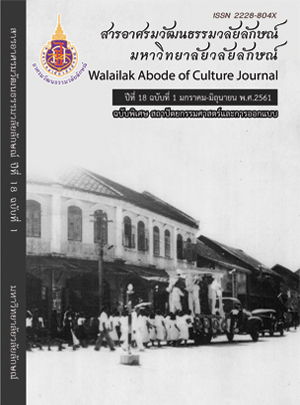Everyday Heritage and the Vibrancy Districts in the Historic Town of Nakhon Si Thammarat
Main Article Content
Abstract
The concept of conservation and development of the present-day cities was developed under the controversy of the Western world and Thai context. Since the Charter for the Conservation of Histoic Towns and Urban Areas or Washington Charter had been adopted by ICOMOS in 1987 after the World Heritage Convention had been issued in 1972. The balance of the development and protection of cultural resources is a core idea to drive sustainable development under Agenda 21. One example from the Conservation and Urban Sustainable Development : A Theoretical Framework Conference in Brazil emphasized on the issue of Integrated Conservation. However, cities have dynamic development which forces the historic cities to face the new constructions and contemporary architecture. The ICOMOS’s International Committee on Historic Towns and Villages adopted the Vienna Memorandum on Historic Urban Landscape in 2005 to promote the idea of historic urban landscape as well as the Valletta Principles for the Safeguarding and Management of Historic Cities, Towns and Urban Areas in 2011 which encourage the co-existence of tangible and intangible aspects in the diversity of the historic cities to establish a better change and intervention within historic values. The Historic Town of Nakhon Si Thammarat periodically developed and layering different meaning which expresses cultural identity until present days along with the everyday life of people and the vibrancy districts in the town and urban. Question would be raised on the ordinary of everyday
landscape which balancing the development, conservation and daily practice of people in order to reach the Sustainable Development Goals (SDGs).
Article Details
© 2018 by Asian Journal of Arts and Culture, Walailak University. All rights reserved.
References
development: A theoretical framework. Recife: Universidade Federal de Pernambuco.
Bourdieu, P. (1977). Outline of a theory of practice. Cambridge: Cambridge University Press.
Feilden, B.M. & Jokilehto, J. (1998). Management guidelines for world cultural heritage sites. Rome: ICCROM.
Fine Arts Department. (1990). Thrissadi lae naeo patibatkan anurak anusonsathan lae laeng borannakhadi [Theory and Practice on Conservation of Historic Structures and Archeology Sites]. Bangkok: Hiranpat Prining.
Ganjanapan, A. (2001). Withi khit choengson nai nganwichai chumchon [The Complex Thinking in Community Research]. Bangkok: Chulalongkorn University Press.
Huachiew Chalermprakiet University. (1997). Raingan kanwichai sanong pra ratcha prasong suang Nakhon Si Thammarat korani suksa 1. Kan tang thinthan thi Krungching lae Phru Khuankhreng 2. Chin : Prawattisat borannakhadi phukhon lae watthanatham [Report of the Research under Royal Desirable on Nakhon Si Thammarat case study 1. Human Settlement at Krungching and Phru Khuankhreng 2. Chinese : History, Archaeology, People and Culture]. Samutprakarn: Dansuttha Printing.
ICOMOS. (1987). Charter for the conservation of historic towns and urban areas. Paris: ICOMOS.
ICOMOS. (2011). The Valletta principles for the safeguarding and management of historic cities, towns and urban areas. Paris: ICOMOS.
Jiraprasertkun, C. (2010). Kan plianplaeng phummithat khong chumchonthongthin nai Krung Thep Mahanakhon lae parimonthon: phonkrathop chak kan tat khrongkhai thanon wongwaen rop nok fang tawantok khong Krung Thep Mahanakhon [The transformation of Bangkok’s Indigenous landscapes: The impacts from the constructions of the Outer Ring Road System on the west of Bangkok]. Bangkok: Thailand Research Fund.
Khwansuwan, P. & Yodsurang, P. (2007). Kan su khwammai muang kao phan phaenthi moradok thang wattanatham : kan su khwannai chak chumchon thongthin [Interpretation of Old Town through Cultural Heritage Atlas: The Interpretation from the Local Communities]. In ICOMOS Thailand International Conference 2007. Bangkok: Amarin Printing.
Lefebvre, H. (1991). The production of space. Oxford: Basil Blackwell.
Lim, S.W. (2003). Alternative (post) modern: An Asian perspective. Singapore: Select Publishing.
Office of Natural Resources and Environmental Policy and Planning (ONEP). (2010). Khringkan kamnot khopkhet phumthi muang kao Muang Nakhon Si Thammarat [The Delimitation of the Old Town Project: The Historic Town of Nakhon Si Thammarat]. Bangkok: ONEP.
Office of Natural Resourcecs and Environmental Policy and Planning (ONEP). (2012). Khrongkan chattham mattrathan khunnaphap singwaetlom sinlapakam praphet yan chumchon kao nai phunthi phak klang lae phak tawan ok [Project on the Environmental Standard of the Cultural Environment in the category of Traditional Communities in the Central and Eastern Regions]. Bangkok: Property Printing.
Tepwongsirirat, P. (2009). Everyday Landscape, Everyday Urbanism: chak mummong thammada khong chiwitprachamwan su singwaetlom sansang [Everyday Landscape, Everyday Urbanism : From the Ordinary Point of View to the Built Environment]. In n/a (Ed.). Krongkan chat oprom kanchattham nganwichai lae wichakan ruang Chimlang Singwaetlom Sansang 2009 [Training Project on the Research on The Pilot Project of the Built Environment Program 2009]. Bangkok: Faculty of Architecture, Kasetsart University.
UNESCO. (2005). Vienna Memorandum on world heritage and contemporary architecture - managing the historic urban landscape. Paris: UNESCO.
UNESCO. (2011). Recommendation on the Historic urban landscape. Paris: UNESCO.
UNESCO. (2013). New Life for historic cities, the historic urban landscape approach explained. Paris: UNESCO.
Yodkamonsart, S. (1997). Thamkhwan ruchak kap khwamkhit Dr.Chatthip Nartsupa chak setthasat Neo Classic su setthasat kanmuang naeo prawattisat lae watthanatham chumchon [Knowing the idea of Dr.Chatthip Nartsupa, from neo classic economy to historic and community culture economy]. Journal of Political Economy, 1, 24-50.


